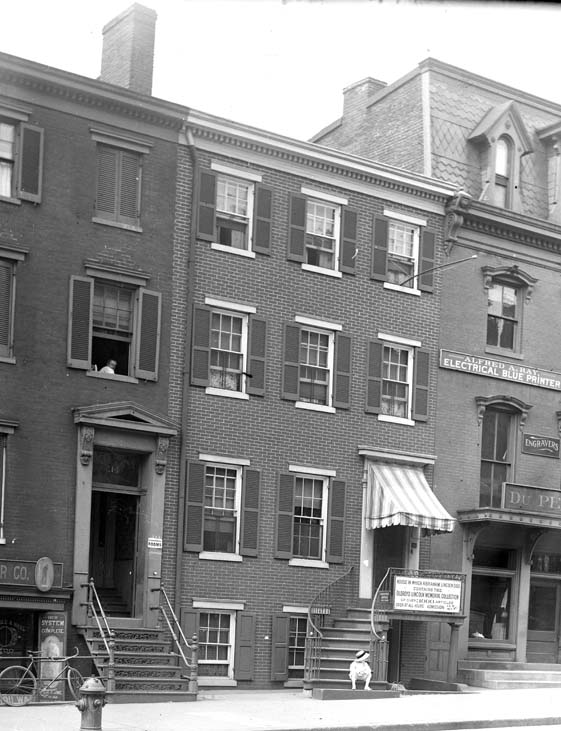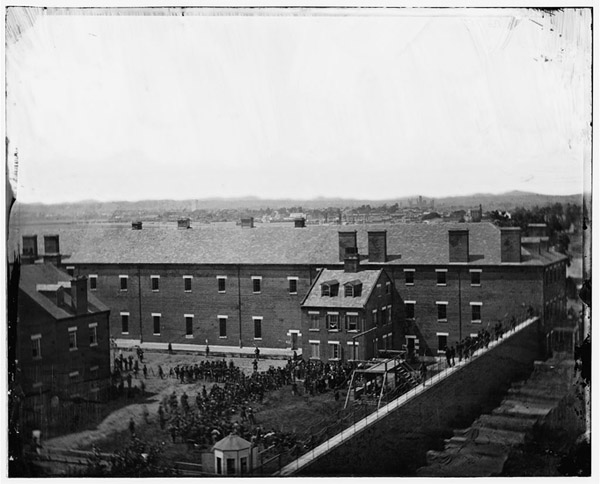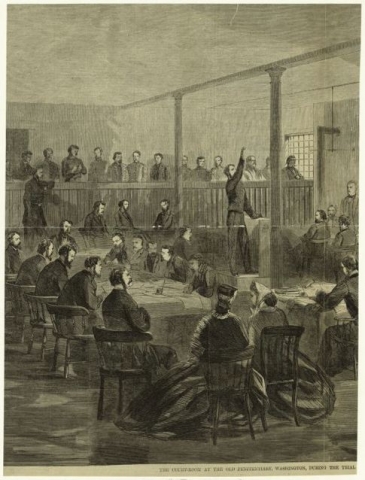
So I just saw the movie The Conspirator last night, opening in the District on the same day that Abraham Lincoln died – April 15, 146 years ago.
I missed the red carpet premiere at Ford’s Theatre last week – complete with director Robert Redford and all the movie’s stars, including Robin Wright, James McAvoy, and Kevin Cline.
But I did get to see the film just three blocks from Ford’s Theatre, where the 16th president was shot on April 14.
And I was just one block away from the boarding house of one of the alleged conspirators, Mary Surratt, whose trial is the subject of the film.
Overall, I thought the movie was fine, and presented some themes familiar to modern day Washingtonians: a stealth terrorist attack on the highest levels
of U.S. government – sleeper agents living among us – inflamed public opinion – civil liberties eroded – military tribunals for the accused conspirators…
Were any of these parallels to post 9-11 America subtle? Not really. The clunky, self-righteous dialogue didn’t help much, either.
The movie sides heavily with Mary Surratt (something which author and Lincoln historian James Swanson decidedly does not), and presents a few theories of its own around the conspiracy and the military trial.
All of this was interesting to follow, but I spent most of the movie with a different preoccupation – looking for glimpses of 19th Century Washington.

They were hard to find, since most of the movie was shot in Savannah, Georgia.
The location did help give the District that swampy Southern look, but it didn’t quite feel right. Old Town Alexandria across the river in Virginia would have been a better (if more expensive) stand-in.
The beginning of the movie takes us along for the ride during the assassination attempts on President Lincoln, Vice President Andrew Johnson, and Secretary of State William H. Seward. It basically condenses the action of Swanson’s two books – Manhunt and Bloody Crimes – into the first 20 minutes of the film.
We see a recreated interior of Ford’s Theatre, as well as Baptist Alley out back, where John Wilkes Booth kept his getaway horse to gallop away down F Street. Although most of D.C.’s downtown alleys have been lost to redevelopment, you can still visit this infamous alley today.
We also see the Petersen House, the home across from Ford’s where Lincoln was taken after the shooting – aka, “The House Where Lincoln Died.”
It’s at 516 10th Street, and is administered as a National Historic site along with the theatre. In a case of bad timing, it’s currently under renovation and expected to reopen to tourists later this year.

Viewers even catch a CGI-enhanced glimpse of the Capitol with its newly completed dome, and the embarrassingly unfinished Washington Monument in the distance.
But the rest of the city scenes are mostly shot at night, and are decidedly more Savannah than D.C. – although they seemed to have gotten the muddy streets and the small-town feel of Civil War-era Washington right.
One thing glaringly missing: Where are the District’s African-American residents? There were tens of thousands of African-Americans living in Washington by the end of the Civil War, many of whom had flocked to the city after D.C.’s Emancipation Day on April 16, 1862 – 149 years ago today.
As far as I can remember, we only see a few in the film, and those are men serving as butlers in distinguished homes, clubs, and hotels.
What the movie really left me wanting to see was the Old Penitentiary, where the conspirators were held throughout their trial, and the setting for most of the action in the movie.
Unfortunately, the prison is no longer standing. It was located at what is now Fort McNair in Southwest Washington – closed to the public after 9-11.
In the movie, it’s depicted as a type of Guantanamo, although when it was
built the penitentiary was a model of prison reform. Ironically, the other accused conspirators who escaped hanging – like Dr. Samuel A. Mudd – were sent to an island prison off of the Florida Keys, not far from the real Guantanamo.
The penitentiary was built on the site of Washington’s Old Arsenal, one of the oldest federal military institutions in the country.

Pierre Charles L’Enfant’s original design for the capital had marked a military base for this area, which had been known as Greenleaf Point – a strategic peninsula at the confluence of the Potomac and Anacostia Rivers.
While you can’t visit the base today, you can get a good glimpse of it across the river from the tip of Hains Point, where the Awakening Statue used to be.
The original installation consisted of the brick buildings of the penitentiary, a courtyard, and a surrounding brick wall. The prison was designed by Charles Bulfinch, who helped rebuild the Capitol after the War of 1812.
It was torn down not long after the trial in 1867-68, and two of the buildings were renovated into officers’ quarters by German Adolf Cluss, the architect of Eastern Market and other notable District buildings.
Today, only one of those building still stands – Grant Hall, Building 20. Luckily, that’s exactly where the trial took place, on the third floor. The U.S. Army Corps of Engineers is currently renovating the courtroom space to its original appearance.

After the movie was over, I took a stroll through the crowded streets of
Chinatown looking for another building from the movie that’s still standing – Mary Surratt’s boarding house. I almost walked by it, as I was looking for 541 H Street.
Street addresses have been altered somewhat since that era, so it’s now located at 604 H Street. The original house is still there, but true to the shifting neighborhood, it’s now a Chinese restaurant.

I’ve passed it countless times before, without noticing the small plaque that marks its significance.
The plaque was placed there by the neighborhood’s Chi-Am Lions Club, and is carefully worded to take no stand on the guilt or even the ultimate crime of Mary Surratt.

That’s something the movie could have taken a lesson from…
Brilliantly written! I want to see the movie regardless of the malarky you pointed out.
Great stuff!! Your passion for the subject really shines through. Keep em coming.
In the photo of the Old Arsenal Prison, not only can you see the scaffold in the prison yard, but the bodies of the four conspirators are still hanging. This was the last of ten photos Alexander Gardner took that day and I’ve always believed (with no evidence to back it up) that the executioner, Christian Rath, waited until Gardner got this photo before taking the bodies down.